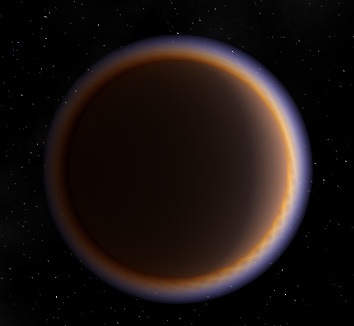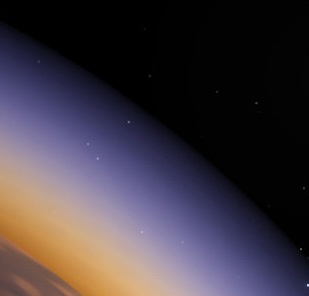

This looks like some interference patterns. Is it related to the screen resolution and FSAA ? Or is it a bug in the atmosphere rendering ?
Also, the atmosphere cut-off is too abrupt, too strong. It doesn't feel very natural.


Cham wrote:I'm using Fridger's parameters for Titan, and I noticed some strange artifacts in the atmosphere, dependant of the observer's position (look at the bottom-right of the moon) :
This looks like some interference patterns. Is it related to the screen resolution and FSAA ? Or is it a bug in the atmosphere rendering ?
Also, the atmosphere cut-off is too abrupt, too strong. It doesn't feel very natural.


Cham wrote:I'm using Fridger's parameters for Titan, and I noticed some strange artifacts in the atmosphere, dependant of the observer's position (look at the bottom-right of the moon) :
This looks like some interference patterns. Is it related to the screen resolution and FSAA ? Or is it a bug in the atmosphere rendering ?
I think it would be best if Celestia automatically did the right thing. The tesselation artifacts you noticed are a bug in Celestia, and I should fix the problem.Cham wrote:Why not define a new parameter to be declared in the SSC, about the planet resolution ? Without this parameter, it's just the default value.
And what about the atmosphere cut-off ?
Greewi wrote:It is not the blue that make problem in my opinion, but the missing lower part of the atmosphere. Perhaps we could add a layer (or a fake layer by using a clone of titan) ?
Ok. I was thinking that it was wrongs parameters.t00fri wrote:Greewi wrote:It is not the blue that make problem in my opinion, but the missing lower part of the atmosphere. Perhaps we could add a layer (or a fake layer by using a clone of titan) ?
The lower part of the atmosphere is there, but the haze is lacking. The Mie atmosphere code just does not yet render it sufficiently opaque.
Fiddling with an additional layer may be fun for an add-on creator at this point in time. But it's certainly not what we are after eventually in the Celestia dev team.
Bye Fridger


fsgregs wrote:Sorry to reactivate this thread, but I have been testing out 1.5.0 final, and I noticed that when I went to Titan, its atmosphere is quite different now in appearance from the images seen here. I realize that the pictures posted earlier on this thread are well over a year old, but as Fridger and Chris pointed out then, they looked quite realistic when compared to photos taken by Cassini.
The Titan atmosphere in 1.5.0 looks very different (much pinker, less orange). I've tried to go to about the same place on Titan. Here are the two images compared:
Fridger's 2006 image:
Titan as seen in 1.5.0 final
I am not complaining. Both atmospheres look great. I was just wondering which one is the more accurate with respect to what Cassini has photographed recently?
Frank